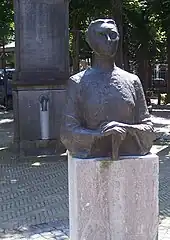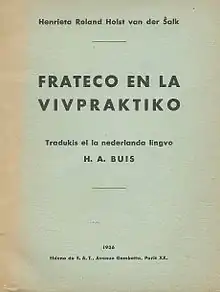Henriette Roland Holst
Henriette Goverdine Anna "Jet" Roland Holst-van der Schalk[lower-alpha 1] (24 December 1869 – 21 November 1952) was a Dutch poet and communist. She was nominated for the Nobel Prize in Literature.[1]
Henriette Roland Holst | |
|---|---|
.jpg.webp) Portrait of Roland Holst by Michel de Klerk (1921) | |
| Born | Henriette Goverdine Anna van der Schalk 24 December 1869 Noordwijk, Netherlands |
| Died | 21 November 1952 (aged 82) Amsterdam, Netherlands |
| Other names |
|
| Occupations |
|
| Political party | |
| Movement | |
| Spouse | |
She had many noted relatives. Her husband was the artist Richard Roland Holst. The poet Adriaan Roland Holst (1888–1976), nicknamed "the Dutch Prince of Poets", was the nephew of her husband.
Early life
Born in Noordwijk on 24 December 1869, Roland Holst was brought up in the affluent, liberal Christian family of the notary Theodore Willem van der Schalk and Anna Ida van der Schalk-van der Hoeven. Roland Holst attended four years of boarding school in Velp and studied French in Liege.[2]
Roland Holst soon came to develop a talent as a poet. She married the artist Richard Roland Holst in 1896[3] and befriended the poet Herman Gorter, who prompted her to read Das Kapital by Karl Marx. Around this time she became politically active and began her career as a writer on political, historical and philosophical fields.[4]
Poetry
Around 1890, Henriette met Albert Verwey,[5] who with Willem Kloos was among the leaders of the Tachtigers and the founders of De Nieuwe Gids. In 1892 she met the painter Jan Toorop. She wrote about Toorop and Verwey in her first sonnets. In these poems she showcased her intense needs as an artist, more precisely: as a poet.
Socialism

At the age of 27 Roland Holst joined the SDAP. She was then working night after night in smoky halls calling for workers' struggle to improve their miserable fate. She became part of the party leadership and, in 1900, was delegated to the Second International. At the conferences of the International, she came into contact with prominent Marxists such as Karl Liebknecht, Rosa Luxemburg, and Leon Trotsky.[6]
In 1911, Roland Holst had joined as an orthodox Marxist in the SDAP. Unlike most other orthodox Marxists, she did not immediately move over to the Social-Democratic Party (SDP, later known as the Communist Party of the Netherlands [CPN]). Against the advice of Rosa Luxemburg in some years she remained non-partisan. She founded in 1915, along with a number of SDAP and SDP members, the Revolutionair Socialistische Vereeniging. While in the CPN, she sided with Herman Gorter, Anton Pannekoek, and the left communist fraction of the party.
"Rode Jet" (meaning "Red Jet", a nickname of Roland Holst) also played a role during the revolutionary turmoil of November 1918. On 13 November she went with David Wijnkoop at the head of a procession on the Orange-Nassau barracks in Amsterdam, to celebrate the brotherhood with the hussars. Intervention by the security forces resulted in two dead, the only victims of the "revolution that did not happen".
1928–1952: Christian socialist
Henriette had deep slumps. She suffered from depression, bouts of anorexia,[7] anemia and heart disease but when she was well she struggled with an unrelenting zeal to improve the position of workers, youth, and women.
Her first poems were passionately for socialism. She wrote among other things, the Dutch text for the anthem "The Internationale". Later, her work took a more religious character. Among her writings were plays, biographies (of Rousseau, Gandhi and Tolstoy), journalism, and radio plays.
During the Second World War she was active in the Dutch resistance,[8] as editor of the resistance magazine De Vonk,[9] then De Vlam. Though of a well to do background, she was certainly not a "salon socialist".
At the end of her life she wrote the autobiography Het vuur brandde voort. She died in Amsterdam on 21 November 1952 at the age of 82. A bust was placed in her memory in her birthplace of Noordwijk in 1969.
Works
Poetry collections
- het Jeugdwerk (1884–1892) (was published in 1969 by Garmt Stuiveling).
- Sonnetten en Verzen in Terzinen geschreven; original edition (graphical treatment by Richard Roland Holst) and Scheltema Holkema's Bookshop, Amsterdam, 1896.
Reprinted in simpler form of being. WL and J. Brusse, Rotterdam in 1913 and 1922 and out. BZZTôH, The Hague 1983.
Political work

- Kapitaal en Arbeid in Nederland, Amsterdam 1902.
- De groote spoorwegstaking, de vakbeweging en de SDAP, Den Haag 1903.
- the Dutch railroad strikes of 1903, and the role of unions and of the SDAP therein.
- Algemeene werkstaking en sociaaldemocratie, Rotterdam 1906.
- this work appeared in German in 1905, with a preface by Karl Kautsky.
- De opstandelingen, Een lyrisch treurspel in drie bedrijven, Amsterdam 1910.
- a lyrical work on the 1905 Russian Revolution.
- De philosophie van Dietzgen en hare beteekenis voor het proletariaat, Rotterdam 1910.
- First published in German, translated by Sam de Wolff.
- Revisionistische en Marxistische tactiek in de kiesrecht-beweging, Rotterdam 1910.
- De strijdmiddelen der sociale revolutie, Amsterdam 1918.
- De revolutionaire massa-aktie. Een studie, Rotterdam 1918.
- De daden der Bolschewiki, Amsterdam 1919.
- written in defense of the Bolsheviks.
- Verslag van het Derde Internationale Communistische Congres, 1921.
- the third congress of the Comintern.
- Uit Sowjet-Rusland, 1921.
- description of her trip to the Third International
- Communisme en moraal, Arnhem 1925.
- Herman Gorter, Amsterdam 1933.
- biography of Tachtiger Herman Gorter.
- Rosa Luxemburg. Haar leven en werk, Rotterdam 1935.
- biography of Rosa Luxemburg.
Notes
- Some sources spell her name as Henriëtte, with a diaeresis, but her birth certificate gives her name without the diaeresis, as do most sources. Her nickname was Jet, and because of her relationship to the poet Adriaan Roland Holst she was often referred to as "Tante Jet" ("Aunt Jet").
References
- "Nomination Database". www.nobelprize.org. Retrieved 19 April 2017.
- Amersfoort, Jaap van; Beek, Pieta van; Schutte, Gerrit (2014). Ora et labora: Twaalf opstellen over christelijke spiritualiteit in de praktijk (in Dutch). Uitgeverij Verloren. p. 132. ISBN 978-90-8704-429-9.
- Muller, Sheila D. (4 July 2013). Dutch Art: An Encyclopedia. Routledge. p. 332. ISBN 978-1-135-49574-9.
- Bel, Jacqueline; Vaessens, Thomas (2010). Women's Writing from the Low Countries 1880-2010: An Anthology. Amsterdam University Press. p. 39. ISBN 978-90-8964-193-9.
- Meijer, Reinder (6 December 2012). Literature of the Low Countries: A Short History of Dutch Literature in the Netherlands and Belgium. Springer Science & Business Media. p. 263. ISBN 978-94-009-9734-9.
- Grever, Maria; Waaldijk, Berteke (23 June 2004). Transforming the Public Sphere: The Dutch National Exhibition of Women’s Labor in 1898. Duke University Press. p. 50. ISBN 978-0-8223-3296-1.
- Etty, Elsbeth (1997). Liefde is heel het leven niet: Henriette Roland Holst, 1869-1952 (in Dutch). Balans. p. 517. ISBN 978-90-5018-503-5.
- Dewulf, Jeroen (2010). Spirit of Resistance: Dutch Clandestine Literature During the Nazi Occupation. Camden House. p. 59. ISBN 978-1-57113-493-6.
- Grünewald, Guido; Dungen, Peter Van den (1995). Twentieth-century Peace Movements: Successes and Failures. E. Mellen Press. p. 178. ISBN 978-0-7734-9065-9.
Further reading
- Jaap van Praag (1911–1981) wrote the first biography of Henriette Roland Holst.
- Herman Schaap - Het leed der mensheid laat mij vaak niet slapen (1984), an anthology from the prose of Henriette Roland Holst, with introduction and notes.
- Elsbeth Etty - Liefde is heel het leven niet (1996). A biography of Roland Holst.
External links
![]() Media related to Henriette Roland Holst at Wikimedia Commons
Media related to Henriette Roland Holst at Wikimedia Commons
- Henriette Roland Holst Archive at marxists.org
- The Communist Left and the resolutions of the second congress of the Communist International, a left communist text by Roland Holst
- Schalk, Henriette Goverdine Anna van der (1869–1952), Biografisch Woordenboek van Nederland
- Biographies, works and texts in the Digitale Bibliotheek voor de Nederlandse Letteren
- Schalk, Henriette Goverdine Anna van der, Biografisch Woordenboek van het Socialisme en de Arbeidersbeweging in Nederland
- Archief Henriëtte Roland Holst-van der Schalk at the International Institute of Social History
- Tussen droom en werkelijkheid. De betekenis van het 'Russische communisme' voor het 'Utopia' van Henriette Roland Holst, doctoral thesis of 1996 of Emma Binnendijk
Poems by Henriette Roland Holst Online
- De zachte krachten zullen zeker winnen (met een uitvoerige bespreking door Pim Heuvel) Archived 27 February 2019 at the Wayback Machine, Klassiekegedichten.net
- Ook ik ben omstreeks ’t midden mijner dagen (besproken door Elly Woltjes) Archived 27 February 2019 at the Wayback Machine, Klassiekegedichten.net
- Enkele gedichten Archived 28 August 2016 at the Wayback Machine, Spiritualiteit.net
- Gedenk mij in uw gebeden! (ook te beluisteren in een gezongen versie) en Over het ontwaken mijner ziel Poëtisch Liedgenootschap